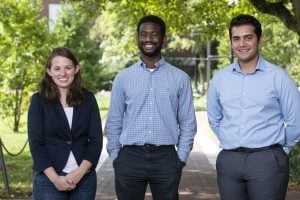
Read the full and original version of this story here.
A team of Johns Hopkins University graduate students from the Department of Electrical and Computer Engineering that invented a sensor that ignores background noise and could improve everything from telemedicine to Zoom calls has won the Runner-Up Award in the Collegiate Inventors Competition.
The honor, announced today, comes with a $5,000 prize. The annual competition, founded by the National Inventors Hall of Fame to encourage innovation and entrepreneurship at the collegiate level, was held virtually this year.
There were 10 finalist teams from nine colleges and universities. Johns Hopkins also had an undergraduate student team that made the finals. Judges were inventors and innovation experts including those from the National Inventors Hall of Fame.
JHU’s winning team of graduate students is called “Hearo,” a name that’s a hat tip to their invention –an acoustic sensor that can detect very specific sounds within in noisy environments. The team of doctoral students leveraged the skills of Ian McLane, who’d already created an electronic stethoscope; Valerie Rennoll, who has a background in creatively using materials to minimize interference; and Adebayo Eisape, who specializes in creating objects that generate their own energy.
“I’m thrilled to have placed in the CIC, it is really rewarding to know that accomplished inventors think our device has the potential to make a real impact,” Rennoll said.
The sensor the team created has many possible uses. It could be part of a wearable device that would detect a patient’s vital signs for remote care-giving. If placed on dolphins or whales, researchers could track their sounds and calls. It could help bands record music without having to use a high-tech studio.
The group tested the device in a number of ways, such as holding it to McLane’s chest while playing loud music and holding it to Rennoll’s neck while playing loud music. They heard his heart beat and her voice – and no music at all. Rennoll, who plays guitar, even affixed the sensor to the guitar while she played it with other loud music in the background. All they heard was the guitar. The team almost couldn’t believe that a device this easy to build and so easily scalable for mass production worked so smoothly.
“Global crises and challenges don’t stop innovation — they accelerate it,” National Inventors Hall of Fame CEO Michael Oister said in a statement. “We are proud to recognize these young inventors who demonstrate the innovation mindset that empowers them to think big and solve the world’s greatest problems.”
The undergraduate team that made the finals, named Benegraft, devised a tool to make it easier for surgeons to perform rhinoplasties.
Johns Hopkins has had finalists in this competition 24 times, and 14 winning teams.
ECE team named finalists in Collegiate Inventors Competition
Read the full and original version of this story in the Hub, which was published on September 29.
A Johns Hopkins University team comprised of ECE graduate students are among the finalists announced today by the Collegiate Inventors Competition (CIC), an annual contest founded by the National Inventors Hall of Fame to encourage innovation and entrepreneurship at the collegiate level.
The team of graduate students is called “Hearo,” a name that’s a hat tip to their invention—an acoustic sensor that can detect very specific sounds within in noisy environments. The team of doctoral students leveraged the skills of Ian McLane, who’d already created an electronic stethoscope; Valerie Rennoll, who has a background in creatively using materials to minimize interference; and Adebayo Eisape, who specializes in creating objects that generate their own energy.
The sensor the team created has many possible uses. It could be part of a wearable device that would detect a patient’s vital signs for remote caregiving. If placed on dolphins or whales, researchers could track their sounds and calls. It could help bands record music without having to use a high-tech studio.
The group tested the device in a number of ways, such as holding it to McLane’s chest while playing loud music and holding it to Rennoll’s neck while playing loud music. They heard his heart beat and her voice—and no music at all. Rennoll, who plays guitar, even affixed the sensor to the guitar while she played it with other loud music in the background. All they heard was the guitar. The team almost couldn’t believe that a device this easy to build and so easily scalable for mass production worked so smoothly.
“That’s one of the things about discovery,” said their advisor, James West, a professor of electrical and computer engineering. “The simple things are the best.”
Competition finalists will present their research and prototypes to some of the most influential invention experts in the nation—National Inventors Hall of Fame Inductees and United States Patent and Trademark Office officials. Teams will do presentations virtually this year on Oct. 28, and the winners will be announced the following day.
An undergraduate team from the Department of Biomedical Engineering has also qualified as finalists for the CIC undergraduate competition. Johns Hopkins has had finalists in this competition 24 times, and 13 winning teams.